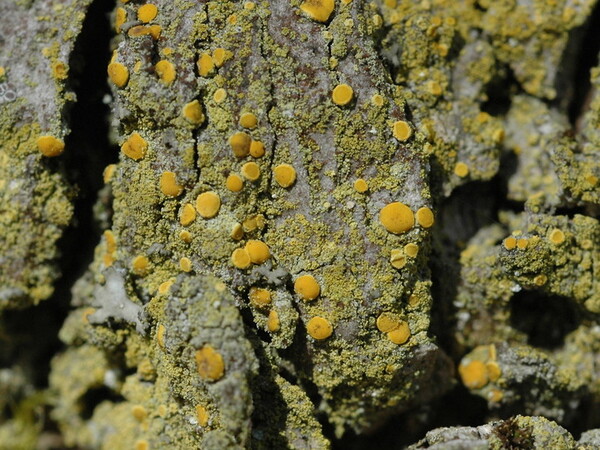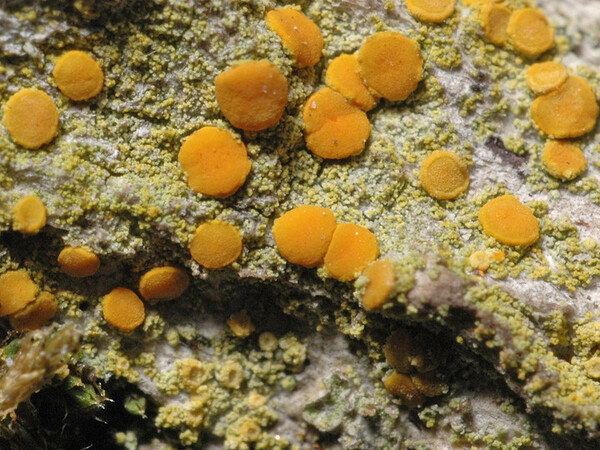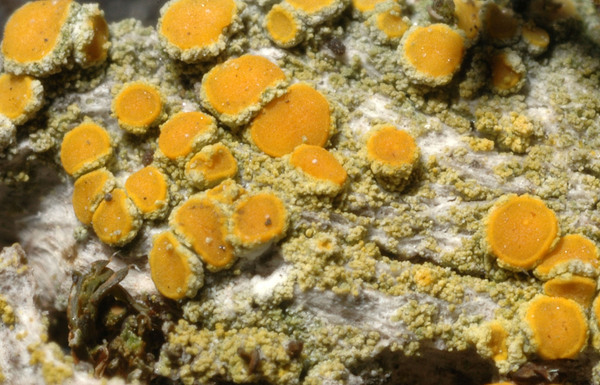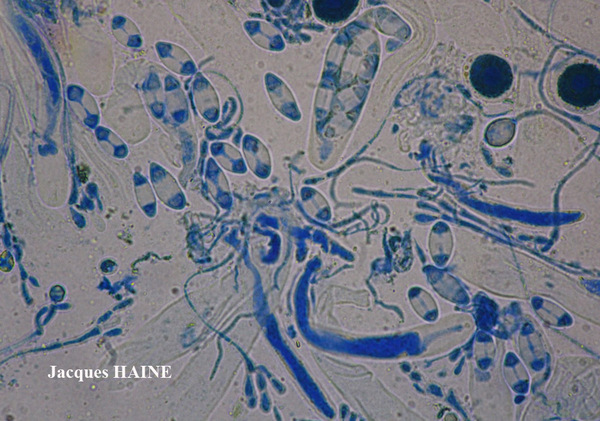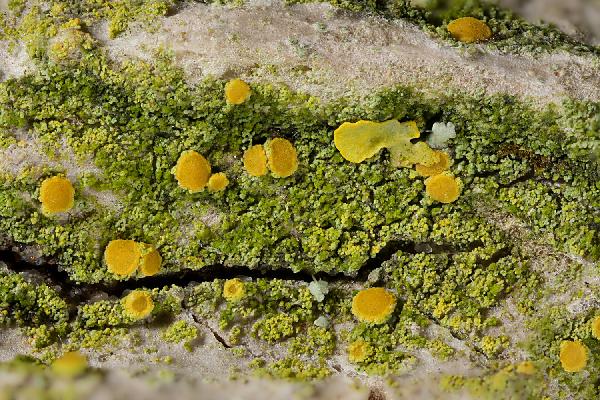Polycauliona phlogina (Ach.) Arup, Frödén & Søchting
in Arup & al., Nord. J. Bot., 31: 53, 2013. Basionym: Parmelia citrina var. phlogina Ach. - Meth. Lich.: 180, 1803.
Synonyms: Caloplaca citrina f. phlogina (Ach.) D. Hawksw.; Caloplaca phlogina (Ach.) Flagey; Scythioria phlogina (Ach.) S.Y. Kondr., Kärnefelt, Elix, A. Thell & Hur
Distribution: N - VG, Frl, Ven, TAA, Lomb, Piem, Emil, Lig. C - Tosc, Marc, Laz, Mol (Ravera & Genovesi 2012, Genovesi & Ravera 2014), Sar. S - Camp, Pugl, Cal, Si.
Description: Thallus crustose, episubstratic, pale yellow-orange to yellowish grey in shade-forms, thin, continuous or consisting of 0.1-0.3 mm wide, convex, round to irregular areoles which are soon completely dissolved into 30-50(-60) µm thick, yellow, grey-yellow or greenish yellow (rarely whitish) soredia tending to spread over the whole thallus surface, forming 0.3-3 cm wide patches. Apothecia usually present, zeorine, sessile to slightly raised, 0.3-0.8(-1.7) mm across, with a deep yellow to orange-yellow, often thinly white-pruinose disc, a usually paler, 25-50(-60) µm thick proper margin, and an often sorediate, finally often excluded thalline margin. Thalline exciple up to 125 µm wide; proper exciple of irregularly radiating, thick-walled hyphae; epithecium yellowish orange, granular, K+ red; hymenium colourless, 55-80 µm high; paraphyses simple to sparingly branched, 1.5-2.5 µm thick, with an enlarged (to 7 µm) apical cell; hypothecium colourless, 25-65 µm high. Asci 8-spored, clavate, functionally unitunicate, apically thickened with a broad internal beak, the inner part of apex and external cap I+ blue, Teloschistes-type. Ascospores 2-celled, polarilocular, hyaline, ellipsoid to broadly ellipsoid, 9-13.5 x 4-7 µm, the equatorial thickening (“septum”) 2.5-5(-6) µm. Pycnidia immersed, orange-yellow. Conidia broadly ellipsoid, 2.5-3.5 x 1.2-1.5 µm. Photobiont chlorococcoid. Spot tests: soredia and apothecia K+ red, C-, KC-, P-. Chemistry: soredia and apothecia with parietin, fallacinal, emodin, teloschistin and parietinic acid corresponding to chemosyndrome A of Søchting (1997). Note: for a long time this species was regarded as a mainly corticolous ecotype of Flavoplaca citrina. According to Sérusiaux & al. (1999) and Arup (2006), it is however distinct, so much that it was included into a different genus, Polycauliona, by Arup & al. (2013). Here I provisionally place all regions from which I have seen epiphytic samples of the F. citrina-group, warning that the whole complex urgently needs a thorough revision in Italy. For further information see Vondrák & al. (2010).
Growth form: Crustose
Substrata: bark
Photobiont: green algae other than Trentepohlia
Reproductive strategy: mainly asexual, by soredia, or soredia-like structures (e.g. blastidia)
Pioneer species
Commonnes-rarity: (info)
Alpine belt: absent
Subalpine belt: absent
Oromediterranean belt: absent
Montane belt: rather rare
Submediterranean belt: common
Padanian area: rather common
Humid submediterranean belt: rather common
Humid mediterranean belt: rather rare
Dry mediterranean belt: rare

Predictive model
Herbarium samples


Felix Schumm – CC BY-SA 4.0
[9252], Spanien, Kanaren, La Gomera: Bei Las Hayas an der Straße nach Arure. 28°07.742' N, 17°17.761 W, 955 m, an Phoenix canariensis.Sonnig, trocken. Leg. F. Schumm, 12.02.2002, et. A. Aptroot 2016.
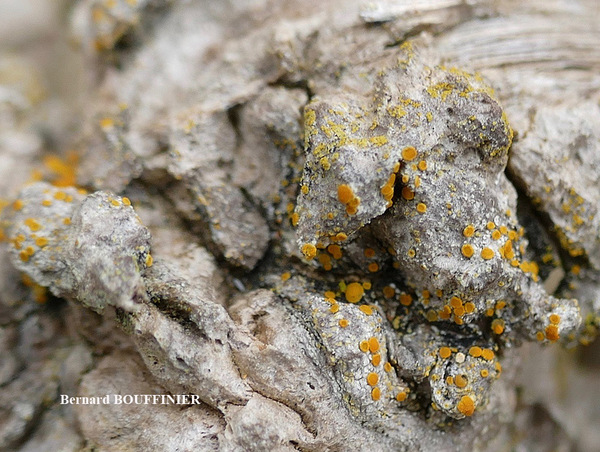
Bernard Bouffinier - Source: http://www.lichensmaritimes.org/index.php?task=fiche&lichen=1024&lang=en
France, Plouarzel
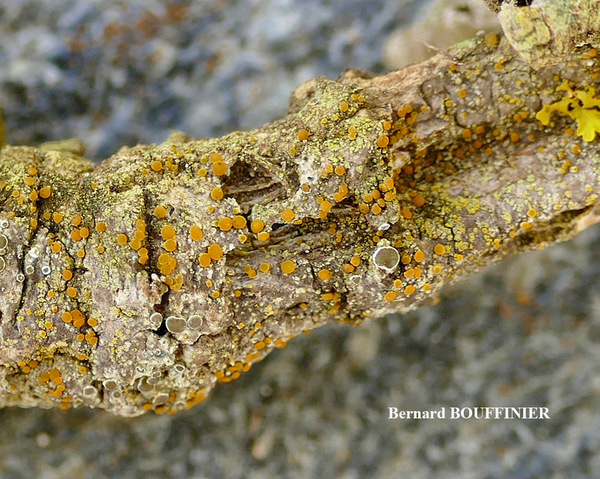
Bernard Bouffinier - Source: http://www.lichensmaritimes.org/index.php?task=fiche&lichen=1024&lang=en
France, Plouarzel
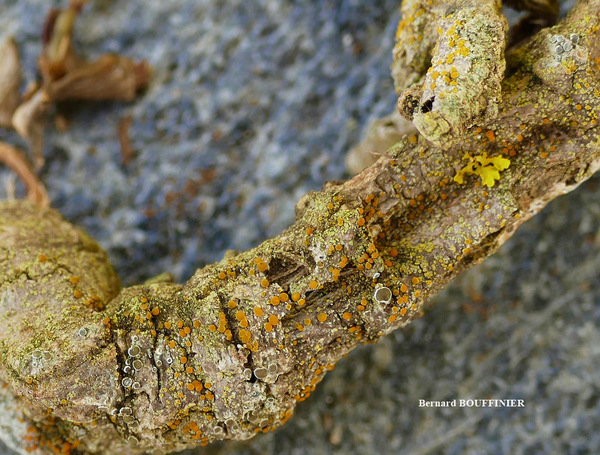
Bernard Bouffinier - Source: http://www.lichensmaritimes.org/index.php?task=fiche&lichen=1024&lang=en
France, Plouarzel
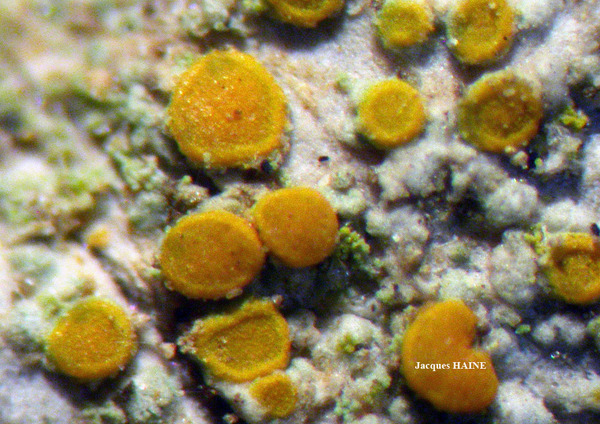
Bernard Bouffinier - Source: http://www.lichensmaritimes.org/index.php?task=fiche&lichen=1024&lang=en
France, Plouarzel
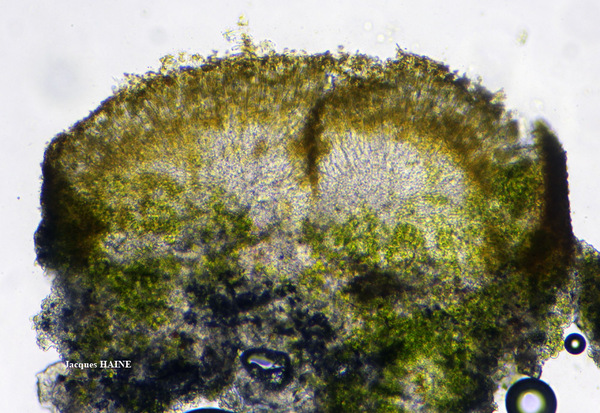
Jacques Haine - Source: http://www.lichensmaritimes.org/index.php?task=fiche&lichen=1024&lang=en
France, Plouarzel
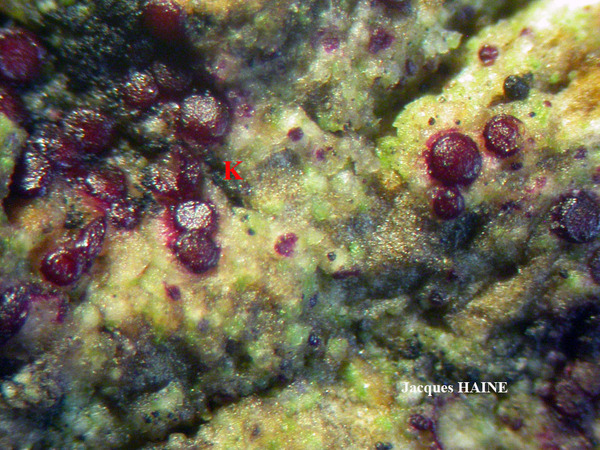
Jacques Haine - Source: http://www.lichensmaritimes.org/index.php?task=fiche&lichen=1024&lang=en
France, Plouarzel

Jacques Haine - Source: http://www.lichensmaritimes.org/index.php?task=fiche&lichen=1024&lang=en
France, Plouarzel
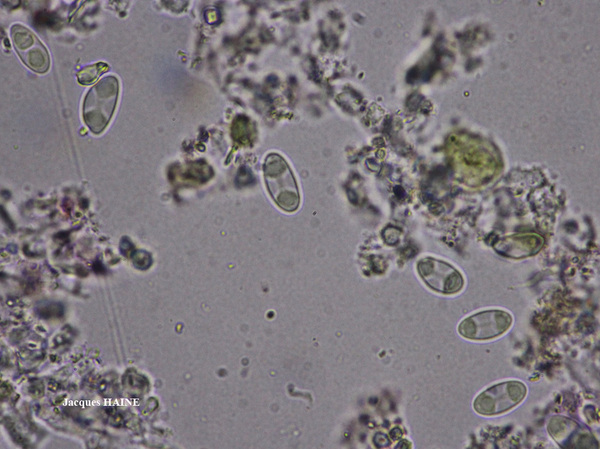
Jacques Haine - Source: http://www.lichensmaritimes.org/index.php?task=fiche&lichen=1024&lang=en
France, Plouarzel

Jacques Haine - Source: http://www.lichensmaritimes.org/index.php?task=fiche&lichen=1024&lang=en
France, Plouarzel
Growth form: Crustose
Substrata: bark
Photobiont: green algae other than Trentepohlia
Reproductive strategy: mainly asexual, by soredia, or soredia-like structures (e.g. blastidia)
Pioneer species
Commonnes-rarity: (info)
Alpine belt: absent
Subalpine belt: absent
Oromediterranean belt: absent
Montane belt: rather rare
Submediterranean belt: common
Padanian area: rather common
Humid submediterranean belt: rather common
Humid mediterranean belt: rather rare
Dry mediterranean belt: rare

Predictive model
| Herbarium samples |


Felix Schumm – CC BY-SA 4.0
[9252], Spanien, Kanaren, La Gomera: Bei Las Hayas an der Straße nach Arure. 28°07.742' N, 17°17.761 W, 955 m, an Phoenix canariensis.Sonnig, trocken. Leg. F. Schumm, 12.02.2002, et. A. Aptroot 2016.

Bernard Bouffinier - Source: http://www.lichensmaritimes.org/index.php?task=fiche&lichen=1024&lang=en
France, Plouarzel

Bernard Bouffinier - Source: http://www.lichensmaritimes.org/index.php?task=fiche&lichen=1024&lang=en
France, Plouarzel

Bernard Bouffinier - Source: http://www.lichensmaritimes.org/index.php?task=fiche&lichen=1024&lang=en
France, Plouarzel

Bernard Bouffinier - Source: http://www.lichensmaritimes.org/index.php?task=fiche&lichen=1024&lang=en
France, Plouarzel

Jacques Haine - Source: http://www.lichensmaritimes.org/index.php?task=fiche&lichen=1024&lang=en
France, Plouarzel

Jacques Haine - Source: http://www.lichensmaritimes.org/index.php?task=fiche&lichen=1024&lang=en
France, Plouarzel

Jacques Haine - Source: http://www.lichensmaritimes.org/index.php?task=fiche&lichen=1024&lang=en
France, Plouarzel

Jacques Haine - Source: http://www.lichensmaritimes.org/index.php?task=fiche&lichen=1024&lang=en
France, Plouarzel

 Index Fungorum
Index Fungorum
 GBIF
GBIF
